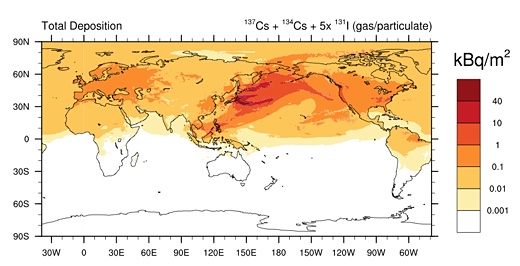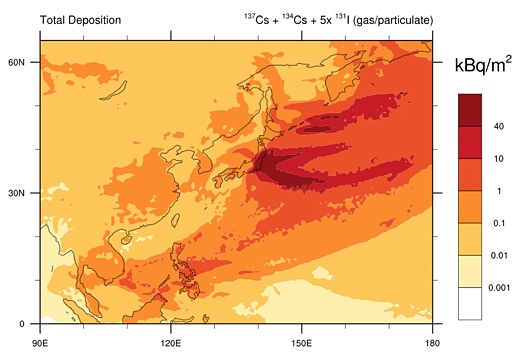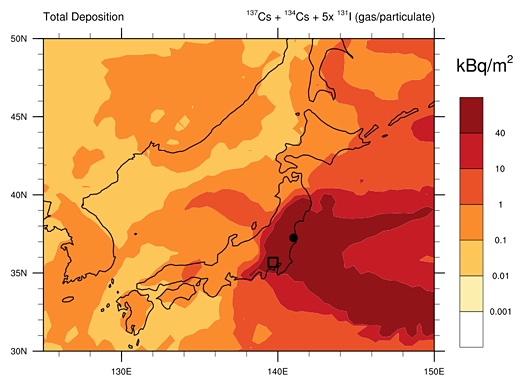SUBHEAD: New insight on the spread of contamination from Fukushima Daiichi nuclear disaster.
Compiled by Staff on 16 February 2014 for ENE News -
(http://enenews.com/govt-report-plutonium-releases-from-fukushima-a-top-concern-uncertainty-over-how-far-molten-fuel-has-eaten-through-what-remained-of-primary-containment)

Image above: Worldwide atmospheric distribution of radioactive Cesium and Iodine from Fukushima Daiichi. From European Commission report below. Click to embiggen.
Excerpts from the European Environment Agency Report
(764 Page PDF: With "Late lessons from Chernobyl, early warnings from Fukushim". Starting on page 450)
Containment Vessels

Image above: East Asian atmospheric distribution of radioactive Cesium and Iodine from Fukushima Daiichi. From European Commission report below.
European Commission, Science for Environment Policy News Alert (pdf) (emphasis added): [...]
This EU-funded study modelled the global spread of radionuclides of caesium and iodine from Fukushima [...] between March and May 2011 [...]
It focused on radionuclides that were emitted as gases [...] The International Atomic Energy Agency defines ’contamination’ as the presence of a radioactive substance in quantities more than 40 kilobecquerels per m². [...] land area affected by radioactivity from both types of radionuclides above this threshold is approximately 34,000 km² of Japan, inhabited by around 9.4 million people. However, the estimate used for the iodine radionuclide emissions from the incident is considered to be an underestimate.
A separate calculation which assumed source emissions that were five times greater, suggested that a relatively large and densely populated part of Japan – 56,000 km² [21,622 square miles] – would be classified as contaminated. [...] It should be emphasised that this refers to two radionuclides only, whereas additional ones are unaccounted for due to a lack of measurements. [...]

Image above: Japanese atmospheric distribution of radioactive Cesium and Iodine from Fukushima Daiichi. From European Commission. Note Black circle is Fukushima Daiichi NPP. Black square is greater Tokyo.
Modelling the global atmospheric transport and deposition of radionuclides from the Fukushima Dai-ichi nuclear accident (pdf), 2013 (emphasis added): Chino et al. (2011) estimate a total [131I] release of 150 PBq [...] results are considered by [the] authors to be lower estimates and to have an error of at least a factor of five. Winiarek et al. (2012) estimate the lower bound of the total activity of 131I released into the atmosphere [...] between 190 and 700 PBq [...]
We estimate that the land area affected by the deposition of radioactivity in excess of 40 kBqm² is approximately 34,000 km². [...] this part of Japan is inhabited by 9.4 million people. The surface area that received a total deposition greater than 10 kBqm² encompasses parts of the Tokyo metropolitan area, and approximately covers 60,000 km2, being inhabited by 46 million people. We emphasize that this is based on the emission of 150 PBq 131I estimated by Chino et al. (2011), which might actually be a factor of five too low.
Discussion Paper (pdf): To test the potential of a larger source than 150 PBq 131I, we performed a sensitivity test by applying 5 times higher emissions, based on the emissions estimate uncertainty by Chino et al. (2011). [...] an area of 56,000 km², inhabited by 43 million people, would be contaminated by more than 40 kBqm², including the Tokyo metropolitan area. Although this large 131I source is speculative, it seems more realistic than the low estimate of 150 PBq [...]
.
Compiled by Staff on 16 February 2014 for ENE News -
(http://enenews.com/govt-report-plutonium-releases-from-fukushima-a-top-concern-uncertainty-over-how-far-molten-fuel-has-eaten-through-what-remained-of-primary-containment)

Image above: Worldwide atmospheric distribution of radioactive Cesium and Iodine from Fukushima Daiichi. From European Commission report below. Click to embiggen.
Excerpts from the European Environment Agency Report
(764 Page PDF: With "Late lessons from Chernobyl, early warnings from Fukushim". Starting on page 450)
Containment Vessels
- Within a few hours the reactor cores of the three operating units were subject to varying degrees of meltdown [...] the reactor pressure vessels themselves had failed and, in various degrees, the primary containment of the pressure suppression system had failed
- Deteriorating situation – with [...] sharp perturbations in containment pressure and radiation levels, particularly within what remained of the primary containment
- There still remained uncertainty about a series of ongoing problems, including the state and level of the nuclear fuel, particularly after confirmation that molten fuel may have eaten through three-quarters of the concrete under Unit #1 and damaged the bases of two of the other reactors
- Of primary concern were fission products, readily absorbed by the human body, and the actinides [e.g. plutonium], which act as heavy metal poisons
- Significantly, there is confirmed isotopic evidence for the release of plutonium into the atmosphere and deposition on the ground in northwest and south of the Fukushima nuclear site
- In order to cope with this level of contamination, and in contradiction to international radiation protection standards, Japanese regulators have raised dose constraints to 20 mSv/year – thereby subjecting schoolchildren to exposures normally only tolerated by adult nuclear workers
- It is clear that there will need to be a significant assessment of a wide range of environmental risk factors

Image above: East Asian atmospheric distribution of radioactive Cesium and Iodine from Fukushima Daiichi. From European Commission report below.
European Commission, Science for Environment Policy News Alert (pdf) (emphasis added): [...]
This EU-funded study modelled the global spread of radionuclides of caesium and iodine from Fukushima [...] between March and May 2011 [...]
It focused on radionuclides that were emitted as gases [...] The International Atomic Energy Agency defines ’contamination’ as the presence of a radioactive substance in quantities more than 40 kilobecquerels per m². [...] land area affected by radioactivity from both types of radionuclides above this threshold is approximately 34,000 km² of Japan, inhabited by around 9.4 million people. However, the estimate used for the iodine radionuclide emissions from the incident is considered to be an underestimate.
A separate calculation which assumed source emissions that were five times greater, suggested that a relatively large and densely populated part of Japan – 56,000 km² [21,622 square miles] – would be classified as contaminated. [...] It should be emphasised that this refers to two radionuclides only, whereas additional ones are unaccounted for due to a lack of measurements. [...]

Image above: Japanese atmospheric distribution of radioactive Cesium and Iodine from Fukushima Daiichi. From European Commission. Note Black circle is Fukushima Daiichi NPP. Black square is greater Tokyo.
Modelling the global atmospheric transport and deposition of radionuclides from the Fukushima Dai-ichi nuclear accident (pdf), 2013 (emphasis added): Chino et al. (2011) estimate a total [131I] release of 150 PBq [...] results are considered by [the] authors to be lower estimates and to have an error of at least a factor of five. Winiarek et al. (2012) estimate the lower bound of the total activity of 131I released into the atmosphere [...] between 190 and 700 PBq [...]
We estimate that the land area affected by the deposition of radioactivity in excess of 40 kBqm² is approximately 34,000 km². [...] this part of Japan is inhabited by 9.4 million people. The surface area that received a total deposition greater than 10 kBqm² encompasses parts of the Tokyo metropolitan area, and approximately covers 60,000 km2, being inhabited by 46 million people. We emphasize that this is based on the emission of 150 PBq 131I estimated by Chino et al. (2011), which might actually be a factor of five too low.
Discussion Paper (pdf): To test the potential of a larger source than 150 PBq 131I, we performed a sensitivity test by applying 5 times higher emissions, based on the emissions estimate uncertainty by Chino et al. (2011). [...] an area of 56,000 km², inhabited by 43 million people, would be contaminated by more than 40 kBqm², including the Tokyo metropolitan area. Although this large 131I source is speculative, it seems more realistic than the low estimate of 150 PBq [...]
.
No comments :
Post a Comment